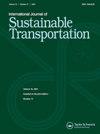城市环境中道路交通噪声污染的时空变化评价及公众对相关健康危害的认知
IF 3.9
3区 工程技术
Q2 ENVIRONMENTAL STUDIES
International Journal of Sustainable Transportation
Pub Date : 2025-10-03
DOI:10.1080/15568318.2025.2526788
引用次数: 0
摘要
道路交通噪声污染被世界卫生组织(世卫组织)确认为对人类健康和福祉的重大威胁,因此有必要通过强大的监测网络准确表征其在城市环境中的时空变化。本研究调查了印度斯利那加的RTN污染、其潜在的健康影响和公众认知。使用校准的声级计(SLM)在43个地点进行了噪声测量,并使用sound - plan 8.2生成的等高线地图来评估环境噪声暴露。对1253名参与者的调查结果显示,67.1%的人暴露在噪音水平超过55分贝(A)的环境中。利用逆距离加权插值和Sound-PLAN模拟,中心城区的峰值噪声水平在67至92.3 dB(A)之间,强调了相当大的健康风险,迫切需要有针对性的缓解策略。预测模型具有较高的准确性,超参数优化模型的R2 = 0.89, MAE = 0.63, MSE = 0.42。人口统计学分析显示,基于性别、教育程度和职业的认知水平差异有统计学意义(p < 0.05)。慢性健康状况、糖尿病(1.49)、心脏病(1.54)、中风(1.41)和高血压(1.86)的平均意识指数得分(AAIS)表明公众对长期健康风险的认识有限。受访者将各种健康问题归因于住宅噪音污染,包括头痛(37%)、睡眠障碍(24%)、烦恼(18%)和压力(15%)。该研究倡导将噪音缓解战略、公共卫生教育和政策驱动的干预措施与国际标准相结合,以有效管理快速城市化背景下不断升级的噪音污染负担。本文章由计算机程序翻译,如有差异,请以英文原文为准。
Evaluation of the spatiotemporal variations of road traffic noise pollution and public cognizance of associated health hazards within urban environments
Road traffic noise (RTN) pollution, recognized by the World Health Organization (WHO) as a significant threat to human health and well-being, necessitates accurate characterization of its spatiotemporal variations in urban environments through robust monitoring networks. This study investigated RTN pollution, its potential health ramifications, and public cognizance in Srinagar, India. Noise measurements were conducted at 43 locations using a calibrated sound level meter (SLM), and Sound-PLAN 8.2 generated contour maps to assess ambient noise exposure. Survey results from 1,253 participants revealed that 67.1% were exposed to noise levels exceeding 55 dB(A). Using Inverse Distance Weighting interpolation and Sound-PLAN simulations, peak noise levels in central urban zones ranged from 67 to 92.3 dB(A), underscoring considerable health risks and the urgent need for targeted mitigation strategies. Predictive modeling demonstrated high accuracy, with hyperparameter-optimized models yielding R2 = 0.89, MAE = 0.63, and MSE = 0.42. Demographic analysis revealed statistically significant differences (p < 0.05) in awareness levels based on gender, education, and occupation. The Average Awareness Index Score (AAIS) for chronic health conditions, diabetes (1.49), heart attack (1.54), stroke (1.41), and hypertension (1.86) indicated limited public cognizance of long-term health risks. Respondents attributed various health issues to residential noise pollution, including headaches (37%), sleep disturbances (24%), annoyance (18%), and stress (15%). The study advocates for the integration of noise mitigation strategies, public health education, and policy-driven interventions aligned with international standards to effectively manage the escalating burden of noise pollution in rapidly urbanizing contexts.
求助全文
通过发布文献求助,成功后即可免费获取论文全文。
去求助
来源期刊
CiteScore
8.90
自引率
2.60%
发文量
56
期刊介绍:
The International Journal of Sustainable Transportation provides a discussion forum for the exchange of new and innovative ideas on sustainable transportation research in the context of environmental, economical, social, and engineering aspects, as well as current and future interactions of transportation systems and other urban subsystems. The scope includes the examination of overall sustainability of any transportation system, including its infrastructure, vehicle, operation, and maintenance; the integration of social science disciplines, engineering, and information technology with transportation; the understanding of the comparative aspects of different transportation systems from a global perspective; qualitative and quantitative transportation studies; and case studies, surveys, and expository papers in an international or local context. Equal emphasis is placed on the problems of sustainable transportation that are associated with passenger and freight transportation modes in both industrialized and non-industrialized areas. All submitted manuscripts are subject to initial evaluation by the Editors and, if found suitable for further consideration, to peer review by independent, anonymous expert reviewers. All peer review is single-blind. Submissions are made online via ScholarOne Manuscripts.

 求助内容:
求助内容: 应助结果提醒方式:
应助结果提醒方式:


